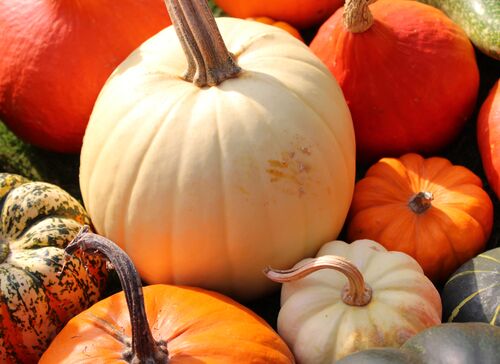Growing and Sowing Pumpkins and Gourds

Gourds, squash and pumpkins are, like cucumber and zucchini, all part of the same botanical family, Cucurbitaceae. Pumpkins and squash are edible, think of grilled pumpkin or pumpkin soup. Gourds are grown for their ornamental value. They are often used as autumn decorations. It is important to know that the pumpkin is usually edible and gourd is usually not edible and can sometimes even be poisonous. Whether they are edible is easy to recognize. An inedible pumpkin or gourd has a very hard skin, little flesh and tastes bitter. So, if you're not sure, taste a small piece first.
Growing your own pumpkins and gourds from seeds
To grow pumpkins and gourds, you need space in your garden. They become huge plants. You can either let them crawl along the ground or climb up against a growth rack. Pumpkins and gourds are generally very suitable for growing in our climate.
Sowing and planting pumpkin and gourd
It is very easy to grow pumpkins and gourds. They require relatively little care. Moreover, they are often very beautiful and there are many different types, sizes, shapes and colours. In addition to being used as a vegetable, they are often used as decoration.
You can start sowing indoors as early as mid-April. This will give the plants a head start and the harvest will be earlier. Water regularly, but make sure the soil is not soaking wet. When the plant is sufficiently large, it can be planted in the garden from late May/early June. If you want to sow directly in the garden, you can do so from mid-May. When sowing, keep in mind the planting distance as they grow very large. This can vary per variety.
Buy different pumpkins Seeds >
Position and soil for Pumpkins
Pumpkins and gourds need a sunny, warm location with well-drained, humus-rich soil. That is why they are often grown on a compost heap. To prevent the growth from stopping, it is important to water them regularly. Do this at the base of the plant and not on the leaves to prevent them from rotting.
How to care for your pumpkin and gourd plants
Pumpkins and gourds require little care. The most important thing is regular watering. In addition, you could top the plants. This results in fewer, but often larger, fruits.
When and how to harvest pumpkins and gourds?
From the end of August/beginning of September you can start harvesting the first pumpkins and gourds. They are ripe as soon as the stem is dried out and brown. The skin must be hard. If frost is forecast, then harvest all pumpkins and gourds. These pumpkins and gourds are not ripe yet and therefore not suitable for long-term shelf storage. If these pumpkins are ripe enough, you could freeze them.
How to preserve pumpkins and gourds?
Preserving pumpkins can be done in several ways. First of all, you can freeze them. You do this by first cleaning them and, if necessary, peeling them. Not all pumpkins need to be peeled, depending on the firmness of the skin. Then blanch them briefly, let them cool down well and put them in the freezer.
Pumpkins can also be stored in a cool, dark place. Do check regularly that they are still good. Most pumpkins can be kept like this for at least a month or two.
Gourds are used for ornamental purposes. They can be stored indoors or outdoors, but it is important that they are dry and frost-free.
Are pumpkins healthy?
Pumpkins are low in calories, rich in fibre and contain many vitamins and minerals. Because they are so high in fibre, they make you feel full quickly.
The pumpkin's flowers are also edible and delicious. You can stuff them, deep-fry them or add them to a salad, for example.
Furthermore, the seeds are also edible and healthy. You can roast them in a pan or in the oven.
Pumpkin and gourd seeds in our collection
In our range we have different types of pumpkins and gourds. Think of the edible tasty Butternut or the soft yellow spaghetti squash and the beautiful Crown of Thorns.
Tips to grow pumpkins and gourd
For a good harvest, it is important that pumpkin plants are planted in a sunny spot and get plenty of water. You can let them grow up against a rack, but also definitely let them crawl across the ground. You can place the pumpkins on stones for to prevent the fruits from getting dirty or affected.
The flowers of the pumpkin are also edible and delicious.
Stick the seeds upright in the soil, this would reduce the chances of the seeds rotting.



